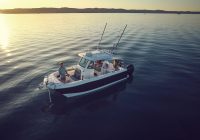The Boating Industry Association’s (BIA) annual State of Industry Survey continues to provide insights into Australia’s marine sector. Now in its 15th year, the 2025 survey offers an opportunity to compare business conditions, workforce trends, and consumer behaviours against the data gathered in 2024. With 180 BIA member businesses contributing to this year’s results, the findings highlight both the resilience and evolving nature of an industry that remains central to Australia’s recreational lifestyle and economy.
In terms of turnover, the industry reported $10.12 billion in 2023–24 compared with a slightly higher $10.2 billion in 2024–25. This represents a modest increase, reflecting stable performance across a challenging economic backdrop. While growth has slowed from the stronger momentum seen in 2023, the latest figures confirm that demand for marine products and services remains consistent.
Business size profiles remain skewed towards smaller operators, with most employing fewer than 10 people. However, in 2025 there was a notable increase in the presence of larger enterprises. Companies with over 50 employees now account for 9% of the workforce, up from 7% in 2024, suggesting consolidation and expansion in key sectors such as boatbuilding and professional services.
Direct employment in the industry shifted slightly. The 2024 report recorded 27,500 people directly employed, plus around 8,250 contractors. In 2025, the number of direct employees was listed at 24,500, but with over 10,000 contractors engaged. This redistribution indicates a growing reliance on flexible and specialist labour, possibly reflecting how businesses are adapting to fluctuating demand and project-based work.
Comparing the industry profile by sector shows some important changes. In 2024, the largest categories were used boat sales (16%) and new boat sales (16%), followed by yard services (12.5%). In 2025, new boat sales held steady at 15%, but used boat sales dropped significantly to 9%. Yard services grew to 15%, while tourism (13%) and mooring/marinas (12.5%) also gained ground.
This shift suggests a maturing of the pandemic-driven second-hand market that peaked in recent years, with consumer focus now moving back to new vessels, marine tourism, and infrastructure services.
At a national level, boating’s popularity remains high, with one in ten Australians holding a licence and more than 2.5 million people licensed across the country. Boat registrations remained broadly stable across all states, with New South Wales, Queensland, and Victoria continuing to lead.
Patterns of boating activity also reveal subtle changes. Preferred activities have remained consistent, boating (32%), fishing (29%), watersports (10%), and cruising (11%) continue to dominate. However, trip duration shifted slightly between 2024 and 2025. The proportion of outings lasting more than 12 hours increased from 7.8% in 2024 to 9% in 2025, while shorter trips (2–4 hours) declined from 26.5% to 24%. This suggests more boaters are spending longer on the water, reflecting stronger confidence in boating as a lifestyle investment.
While headline turnover shows only marginal growth, the structural changes beneath the surface point to an industry in transition. The rise in contract workers, stronger representation of larger firms, and sectoral shifts towards tourism and yard services all highlight how the industry is diversifying.
The decline in used boat sales is particularly significant. It may reflect both supply shortages and a cooling of the “catch-up” buying that dominated the post-COVID years. Meanwhile, the stability of new boat sales, coupled with steady retail, engine sales, and marina services, indicates a baseline strength in the recreational boating economy.
The 2024 and 2025 BIA State of Industry Surveys paint a picture of a sector navigating change with resilience. Modest revenue growth, stable employment, and sustained consumer engagement confirm the industry’s enduring appeal. Yet the rebalancing between used and new boat sales, the rise of larger enterprises, and the growing role of tourism signal an industry evolving in response to new market dynamics.
As the industry looks to the year ahead, the data underscores the importance of innovation, investment, and workforce adaptability to ensure continued growth and relevance in Australia’s national lifestyle and economy.
Some headline numbers:
Turnover:
- 2024: $10.12 billion
- 2025: $10.2 billion
- Slight increase, confirming steady demand but slower growth compared with previous post-pandemic years.
Employment:
- 2024: 27,500 directly employed plus 8,250 contractors
- 2025: 24,500 directly employed plus 10,000+ contractors
- Shift towards contract and project-based work, reflecting flexibility and cost management strategies by businesses.
Business structure:
- Majority still small, under 10 employees.
- Companies with 50+ staff grew from 7% in 2024 to 9% in 2025, showing continued consolidation and larger operations emerging.
Licences and Ownership:
- Both years report 2.5 million boat licences, confirming that 1 in 10 Australians remain active boaters.
- Registrations stayed steady across states, with NSW, Queensland, and Victoria leading.
Preferred Activities:
2024 and 2025 remain consistent:
- Boating: 32%
- Fishing: 29%
- Cruising: 11%
- Watersports: 10%
- Sailing: 7%
- Paddling: 6%
- Yacht racing: 2%
- Other: 3%







